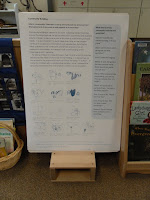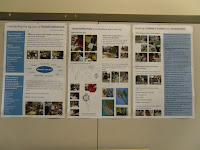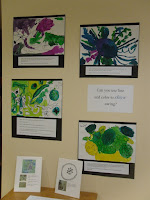
Imaginative Education Summer Training
Vancouver, British Columbia
DAY THREE
Learning in Depth

And now for something completely different ... perhaps. On Day Three of this training, we veered into a different idea for curricular implication entirely. While Imaginative Education offers frameworks for planning class lessons and units on topics of every field, Learning in Depth (LiD) is a proposal for what might be considered enriched learning time for students as individuals. Here the proposal, from the LiD website:
Learning in Depth is a program in which each child is given, during the first week of schooling, a particular topic to learn about through her or his whole school career, in addition to the usual curriculum. Topics might include such things as apples, ships, the circus, cats, the solar system, etc. Students will meet regularly with their supervising teachers, who will give guidance, suggestions, and help as students build personal portfolios on their topics. The aim is that each child, by the end of her or his schooling, will have built genuine expertise about that topic. The expectation is that this process will transform for most children their relationship to, and understanding of the nature of, knowledge. It should transform for each child the experience of schooling.
You best believe that last part resonates with me. If we could all be so lucky as to experience a transformation in our relationship to knowing, learning, and schooling ... !!
To clarify, the proposal is to introduce an opportunity for students to become experts on a particular topic by having them research it from Kindergarten through 12th grade. Nothing like this has ever been done before, so it's hard to say what the results will be. However, as Egan says in his book on the proposal (in press): "Because there is no data about its results, we can't implement it, and if we can't implement it, there will be not data. This seems a bit Catch-22-ish. ... This view would, of course, have prevented every educational innovation in history from getting off the ground."
Most of the morning was spent on introducing the proposal, anticipating objections and responses, and examining the criteria for such topics. At the moment, the major criterion is that topics need to be complex, varied, and multi-dimensional in the following ways:
- Sufficient breadth, sufficient depth (e.g. apples, ants, the wheel, etc.)
- Connections within ourselves: cultural ties as well as emotional and imaginative ties
- Not concerned with material that will lead to depression or violence (e.g. weapons)
- Not too technical
- Not too general nor particular ("animals" is too general, "tigers" is too specific > "cats" will do)
- Must provide an equivalently rich experience for all
In small groups, we discussed additional criteria. One prevalent theme that came up was the cultural slant of topics. It was clear from the list that Egan's team has already generated that the ideas for topics had come from a Western mind. Does this mean they will be culturally offensive? Not necessarily, though "sacred buildings" might be objected to, for example. Egan is certainly always open to new topics, and I would be very curious what topics are generated from non-Western minds. But the criterion of "no cultural offenses" was discussed as a clarifier to the criterion that already addresses culture.
I had an additional idea later that the topics should not be abstract concepts (as some of the suggestions Egan has received have been): love, for example, or loyalty, courage, etc. It seems they need to be concrete, observable, researchable topics with materials that students can interact with. Obviously, such abstract concepts can and "should" be found and examined through the study of concrete topics, as all of learning has both concrete and abstract meaning. But that's just my take.
We were lucky to have some teachers from Corbett School District, that have implemented both an IE curriculum model, and the LiD proposal into their schools. They shared some portfolios and stories of their students, largely praising its many consequences. Interestingly, the most positive of these consequences were largely unexpected by Egan and his team behind the proposal; for example, several teachers mentioned the social networking among students that has really bloomed as they identify connections between each other's topics and even encourage each other by bringing in valuable information sources, materials, etc., that relate to each other's topics. Friendships are even being forged through topic connections, as one teacher reported.
While I was pleasantly surprised by this outcome, I had to kick myself for being surprised at all. Of course! In a graduate course on Socialization, the big message we all got from the research we looked at is that children are primarily socialized by their peers, with parents, teachers, and other adults trailing far behind. Why shouldn't they, then, look to their peers to further their independent learning?
Social networking is certainly an active niche of research at the moment, one that I am not entirely familiar with at the moment. However, it was inspiring to think of what this kind of proposal could allow to observe in the classroom: how children learn when left to their own devices. What sources do they seek? What questions do they pose? What kinds of understanding do they express in these actions?
What insights would answers to these questions offer on the validity of Egan's theory of cognitive tools and kinds of understanding? Or any other ideas about how children learn, for that matter? I can just hear Kieran Egan saying: "Well that's a great question. Why don't you write a dissertation on that?" Who knows? Maybe I will do just that ...
Learning in Depth is a program in which each child is given, during the first week of schooling, a particular topic to learn about through her or his whole school career, in addition to the usual curriculum. Topics might include such things as apples, ships, the circus, cats, the solar system, etc. Students will meet regularly with their supervising teachers, who will give guidance, suggestions, and help as students build personal portfolios on their topics. The aim is that each child, by the end of her or his schooling, will have built genuine expertise about that topic. The expectation is that this process will transform for most children their relationship to, and understanding of the nature of, knowledge. It should transform for each child the experience of schooling.
You best believe that last part resonates with me. If we could all be so lucky as to experience a transformation in our relationship to knowing, learning, and schooling ... !!
To clarify, the proposal is to introduce an opportunity for students to become experts on a particular topic by having them research it from Kindergarten through 12th grade. Nothing like this has ever been done before, so it's hard to say what the results will be. However, as Egan says in his book on the proposal (in press): "Because there is no data about its results, we can't implement it, and if we can't implement it, there will be not data. This seems a bit Catch-22-ish. ... This view would, of course, have prevented every educational innovation in history from getting off the ground."
Most of the morning was spent on introducing the proposal, anticipating objections and responses, and examining the criteria for such topics. At the moment, the major criterion is that topics need to be complex, varied, and multi-dimensional in the following ways:
- Sufficient breadth, sufficient depth (e.g. apples, ants, the wheel, etc.)
- Connections within ourselves: cultural ties as well as emotional and imaginative ties
- Not concerned with material that will lead to depression or violence (e.g. weapons)
- Not too technical
- Not too general nor particular ("animals" is too general, "tigers" is too specific > "cats" will do)
- Must provide an equivalently rich experience for all
In small groups, we discussed additional criteria. One prevalent theme that came up was the cultural slant of topics. It was clear from the list that Egan's team has already generated that the ideas for topics had come from a Western mind. Does this mean they will be culturally offensive? Not necessarily, though "sacred buildings" might be objected to, for example. Egan is certainly always open to new topics, and I would be very curious what topics are generated from non-Western minds. But the criterion of "no cultural offenses" was discussed as a clarifier to the criterion that already addresses culture.
I had an additional idea later that the topics should not be abstract concepts (as some of the suggestions Egan has received have been): love, for example, or loyalty, courage, etc. It seems they need to be concrete, observable, researchable topics with materials that students can interact with. Obviously, such abstract concepts can and "should" be found and examined through the study of concrete topics, as all of learning has both concrete and abstract meaning. But that's just my take.
We were lucky to have some teachers from Corbett School District, that have implemented both an IE curriculum model, and the LiD proposal into their schools. They shared some portfolios and stories of their students, largely praising its many consequences. Interestingly, the most positive of these consequences were largely unexpected by Egan and his team behind the proposal; for example, several teachers mentioned the social networking among students that has really bloomed as they identify connections between each other's topics and even encourage each other by bringing in valuable information sources, materials, etc., that relate to each other's topics. Friendships are even being forged through topic connections, as one teacher reported.
While I was pleasantly surprised by this outcome, I had to kick myself for being surprised at all. Of course! In a graduate course on Socialization, the big message we all got from the research we looked at is that children are primarily socialized by their peers, with parents, teachers, and other adults trailing far behind. Why shouldn't they, then, look to their peers to further their independent learning?
Social networking is certainly an active niche of research at the moment, one that I am not entirely familiar with at the moment. However, it was inspiring to think of what this kind of proposal could allow to observe in the classroom: how children learn when left to their own devices. What sources do they seek? What questions do they pose? What kinds of understanding do they express in these actions?
What insights would answers to these questions offer on the validity of Egan's theory of cognitive tools and kinds of understanding? Or any other ideas about how children learn, for that matter? I can just hear Kieran Egan saying: "Well that's a great question. Why don't you write a dissertation on that?" Who knows? Maybe I will do just that ...


 2010 Summer Symposium
2010 Summer Symposium




























